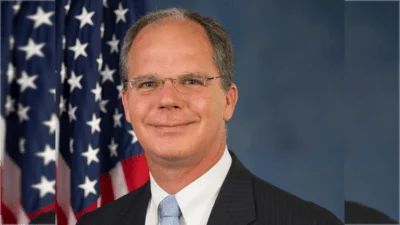Dear Mr. Weldon:
The U.S. Senate Committee on Finance (Committee) began its review of pharmaceutical manufacturers’ use of educational grants last June. Your company submitted information in response to the Committee’s initial request. In the months since, the Committee has continued its review of the use of educational grants to finance healthcare provider and patient education and the potential impact of educational grants on drug utilization and, therefore, the Medicare and Medicaid programs.
The Committee appreciates your company’s cooperation and compliance and requests further assistance as its review of issues relating to the Medicare and Medicaid programs’ coverage of prescription drugs moves forward.
After reviewing information provided by drug manufacturers in response to the Committee’s initial request and from other sources, the Committee seeks additional information about certain practices.
Most notably, as Chairman and Ranking Member of the Committee, we seek to better understand the role(s) of sales and marketing personnel in initiating and/or evaluating grants, and the use of grants to provide funding to professional societies or associations and patient advocacy organizations. With respect to the role of sales and marketing personnel in the grant approval process, we are concerned that sales and marketing personnel may influence the awarding of grants in a way that favors those individuals or organizations that are known to advocate use of specific product(s). With respect to the use of educational grants to fund professional and patient advocacy organizations, we are concerned that such organizations, many of which develop treatment or practice guidelines, may come to rely on such funding to an extent that may compromise their independence. The Committee is also interested in funding provided to academic institutions or state agencies to support the development of practice guidelines or treatment algorithms.
The information provided by your company in response to the Committee’s questions about its underwriting of efforts to promote the use of Propulsid in children raises additional questions. In addition to information specific to one physician and two medical societies, your company provided information about 117 grant payments made between 1997 and 1999 in connection with both research and educational grants for Propulsid. Documentation relating to these payments identified officials from your company involved in authorizing most of the payments variously as:
Product Director Product Director, Gastroenterology Product Director, Propulsid Brand Propulsid Product Manager Senior Product Director, Propulsid Senior Brand Director, Propulsid Director of Medical Business Development, Gastroenterology Director of Market Development, Gastroenterology GI Franchise Director Director Segment Marketing Business Segment Director, GI products
Most, if not all, of these titles appear to relate to positions involved in sales and/or marketing. The apparently significant role played by marketing in approving these grants suggests that education may have been secondary to the promotion of Propulsid. In fact, a number of the payments have no apparent relation to education. For example:
In 1998, a grant was made to support a trust apparently formed by, and named for, a physician who received a significant amount of research and educational funds from your company at his home institution. Payment was directed to the physician at his home institution.
In 1999, a grant was made to support a university’s alumni reception at the annual meeting of a medical specialty society. The grant was made at the request of a physician who also received significant research and educational funds from your company at his home institution.
In 1999, two organizations received grants to support the presidency of a specific physician who also received a significant amount of research and fellowship grant funding from your company at his home institution. The physician directed that payments be made to these organizations.
Finally, the Committee notes that from 1997 through 1999, four individuals each received more than
$175,000 in research and education grants in connection with Propulsid. During this same time period, a pediatric gastroenterologist then associated with a children’s hospital, who was a strong advocate for pediatric use of Propulsid, also received more than $150,000 associated with Propulsid.
It appears that by funding these specific individuals so extensively, your company was attempting to build “key opinion leaders," who influence their peers' medical practice, including but not limited to prescribing behavior. It is not clear whether extensive research and educational grant funding influenced the opinions or message of these physicians with respect to Propulsid. The intent behind this funding appears to have been to increase the influence of physicians who had already identified themselves as proponents of Propulsid, both for FDA-approved and off-label uses.
Information provided about grant payments associated with Propulsid also raises another concern,
i.e., manufacturers appear to provide extensive funding to professional and patient advocacy organizations, which may become so reliant on industry funding that it may compromise their independence. From 1997 to 1999, your company provided significant funding (between $600,000 and $1 million)[1] to two medical specialty societies, and one professional association; all three of these organizations develop practice guidelines.[2] From 1996 to 2000, your company also provided more than $1.3 million to a patient advocacy organization whose advisory board was chaired by the same pediatric gastroenterologist who received significant funding from your company.
These organizations continue to operate and receive grants. According to their tax returns, in fiscal year 2002, revenue from gifts, grants and contributions as a percentage of total support ranged from
5.8 percent to 42.2 percent. Industry funding may also be included as gross receipts from services performed that are related to the organizations charitable purpose. According to its fiscal year 2000 tax return, a patient advocacy organization filed and was approved for dissolution in 2000 because it was unable to raise sufficient funds to pursue its goals. Prior to 2000, most of the support received by the organization was in the form of gifts, grants and contributions - more than $1 million from
1996 through 1999 - almost the exact amount of funding your company provided for the same time period. Thus, it appears that without support from your company, the organization ceased to exist.
The funding provided to two organizations, including the now-defunct patient advocacy organization, is particularly questionable because both organizations deal/dealt primarily with the pediatric population but Propulsid was never approved for use in children. In response to the Committee’s letter requesting information on educational grants related to Propulsid, your company characterized its support of the two organizations as part of an effort to inform pediatricians about Propulsid’s appropriate use in response to a request from the Food and Drug Administration (FDA).
It is not clear from the documentation provided by your company what was requested from these organizations because your company did not provide grant agreements associated with any of the payments about which it provided information.
We recognize that the information described above represents past practices and might not continue under current policies and procedures. In reviewing documentation submitted in response to our initial request, our Committee staff found that many manufacturers have modified their grant policies and procedures in response to the PhRMA Code, issued in 2002, and the Department of Health and Human Services Office of Inspector General’s OIG Compliance Program Guidance for Pharmaceutical Manufacturers, issued in 2003. However, it appears that many manufacturers’, sales and/or marketing personnel still have a role in originating or evaluating grant requests, and,
consequently, the potential for abuse remains. In addition, it appears that most manufacturers continue to provide funding to professional societies and patient advocacy organizations, but the information received by the Committee shows that only one drug manufacturer considers the portion of funding provided to such organizations when evaluating grant requests. Accordingly, we remain concerned about both the direct and indirect influence that manufacturers may have on such organizations. Accordingly, as Chairman and Ranking Member, we request that your company provide the following information to the Committee:
1. Please describe in detail the role(s) of marketing and/or sales personnel in receiving,
processing and/or evaluating grants.
2. Please provide a list of all grants or other payments made to medical/physician/professional organizations or “medical specialty societies" in fiscal years 2003 and 2004. The list should identify the name of the organization receiving the grant or other payment, the amount of the grant or other payment, the date of the grant or other payment, the purpose of the grant or other payment and a description of the activity funded. In addition, please indicate whether the grant or other payment supported, either directly or indirectly, the following:
the development and/or dissemination of journal articles and/or other published material;
the development and/or dissemination of practice or treatment guidelines; and/or the development, dissemination and/or implementation of medication algorithms.
For all grants identified in Question 2 as supporting published materials, practice or treatment guidelines and medication algorithms, either directly or indirectly, please provide the title, journal of publication (if applicable), date of publication, and any method of dissemination other than publication in a peer-reviewed journal.
3. Please provide a list of all grants or other payments made to patient education or advocacy organizations in fiscal years 2003 and 2004. The list should identify the name of the organization receiving the grant or other payment, the amount of the grant or other payment,
the purpose of the grant or other payment, and a description of the activity funded.
4. For each organization that received a grant identified in response to Questions 2 and 4, please indicate whether your company determined and/or considered the total amount of support your company provided to the organization as a percentage of its total funding.
5. Please provide a list of all grants or other payments made to academic institutions or state agencies and/or their agents or employees in fiscal years 2003 or 2004 that supported, either directly or indirectly, the following:
the development and/or dissemination of journal articles and/or other published material;
the development and/or dissemination of practice and/or treatment guidelines; and/or
the development, dissemination and/or implementation of medication algorithms.
The list should identify the following: the name of the institution, agency, or individual receiving the grant or other payment; the title of the article, guideline, or treatment algorithm; the journal of publication (if applicable); the date of publication, and any method of dissemination other than publication in a peer-reviewed journal.
Please provide the information and documents requested in Questions 1 through 6 by February 6, 2006. In complying with this request, please respond by repeating the enumerated request, followed by the accompanying response; attach and identify all relevant documents or data by title and the number(s) of the enumerated request(s) to which they are responsive. In responding to questions 2, 3, 4 and 6 please use the attached excel template.
Sincerely,
Chuck Grassley
Chairman
Max Baucus Ranking Member
-------------------------------------------------------------------------
[1] Totals include some payments that were split between Propulsid and another account. Because the Committee only requested information on Propulsid, this raises the possibility that your company may have provided additional funding from other drug accounts to these organizations.
[2] Information on treatment guidelines is available at the National Guideline Clearinghouse
(www.guideline.gov) run by the Agency for Healthcare Research and Quality. Two of the three professional organizations that received significant funding from your company are identified in the National Guideline Clearinghouse as medical specialty societies and the other is identified as a professional association.
-------------------------------
January 9, 2006
Dear ________________:
The U.S. Senate Committee on Finance (Committee) began its review of pharmaceutical manufacturers’ use of educational grants last June. Your company submitted information in response to the Committee’s initial request. In the months since, the Committee has continued its review of the use of educational grants to finance healthcare provider and patient education and the potential impact of educational grants on drug utilization and, therefore, the Medicare and Medicaid programs.
The Committee appreciates your company’s cooperation and compliance and requests further assistance as its review of issues relating to the Medicare and Medicaid programs’ coverage of prescription drugs moves forward.
After reviewing information provided by drug manufacturers in response to the Committee’s initial request and from other sources, the Committee seeks additional information about certain practices.
Most notably, as Chairman and Ranking member of the Committee we seek to better understand the role(s) of sales and marketing personnel in initiating and/or evaluating grants, and the use of grants to provide funding to professional societies or associations and patient advocacy organizations. With respect to the role of sales and marketing personnel in the grant approval process, we are concerned that sales and marketing personnel may influence the awarding of grants in a way that favors those individuals or organizations that are known to advocate use of specific product(s). With respect to the use of educational grants to fund professional and patient advocacy organizations, we are concerned that such organizations, many of which develop treatment or practice guidelines, may come to rely on such funding to an extent that may compromise their independence. The Committee is also interested in funding provided to academic institutions or state agencies to support the development of practice guidelines or treatment algorithms.
The information provided by some companies in response to the Committee’s first letter inquiring about educational grants and other inquiries about the underwriting of efforts to promote the use of drugs raises additional questions. We recognize that much of this information represents past practices and might not continue under current policies and procedures. In reviewing documentation submitted in response to our initial request, our Committee staff found that many manufacturers have modified their grant policies and procedures in response to the PhRMA Code, issued in 2002, and the Department of Health and Human Services Office of Inspector General’s OIG Compliance Program Guidance for Pharmaceutical Manufacturers, issued in 2003. However, it appears that many manufacturers’, sales and/or marketing personnel still have a role in originating or evaluating grant requests, and, consequently, the potential for abuse remains. In addition, it appears that most manufacturers continue to provide funding to professional societies and patient advocacy organizations, but the information received by the Committee shows that only one drug manufacturer considers the portion of funding they provide to such organizations when evaluating grant requests.
Accordingly, we remain concerned about both the direct and indirect influence that manufacturers may have on such organizations. Accordingly, as Chairman and Ranking Member, we request that your company provide the following information to the Committee:
1. Please describe in detail the role(s) of marketing and/or sales personnel in receiving,
processing and/or evaluating grants.
2. Please provide a list of all grants or other payments made to medical/physician/professional organizations or “medical specialty societies" in fiscal years 2003 and 2004. The list should identify the name of the organization receiving the grant or other payment, the amount of the grant or other payment, the date of the grant or other payment, the purpose of the grant or other payment and a description of the activity funded. In addition, please indicate whether the grant or other payment supported, either directly or indirectly, the following:
the development and/or dissemination of journal articles and/or other published material;
the development and/or dissemination of practice or treatment guidelines; and/or the development, dissemination and/or implementation of medication algorithms.
3. For all grants identified in Question 2 as supporting published materials, practice or treatment guidelines and medication algorithms, either directly or indirectly, please provide the title, journal of publication (if applicable), date of publication, and any method of dissemination other than publication in a peer-reviewed journal.
4. Please provide a list of all grants or other payments made to patient education or advocacy organizations in fiscal years 2003 and 2004. The list should identify the name of the organization receiving the grant or other payment, the amount of the grant or other payment,
the purpose of the grant or other payment, and a description of the activity funded.
5. For each organization that received a grant identified in response to Questions 2 and 4, please indicate whether your company determined and/or considered the total amount of support your company provided to the organization as a percentage of its total funding.
6. Please provide a list of all grants or other payments made to academic institutions or state agencies and/or their agents or employees in fiscal years 2003 or 2004 that supported, either directly or indirectly, the following:
the development and/or dissemination of journal articles and/or other published material;
the development and/or dissemination of practice and/or treatment guidelines; and/or
the development, dissemination and/or implementation of medication algorithms
The list should identify the following: the name of the institution, agency, or individual receiving the grant or other payment; the amount of the grant or other payment; the date of the grant or other payment; the title of the article, guideline, or treatment algorithm; the journal of publication (if applicable); the date of publication, and any method of dissemination other than publication in a peer-reviewed journal.
Please provide the information and documents requested in Questions 1 through 6 by February 6,
2006. In complying with this request, please respond by repeating the enumerated request, followed by the accompanying response; attach and identify all relevant documents or data by title and the number(s) of the enumerated request(s) to which they are responsive. In responding to questions 2,
3, 4 and 6 please use the attached excel template.
Sincerely,
Chuck Grassley
Chairman
Max Baucus Ranking Member
Source: Ranking Member’s News









